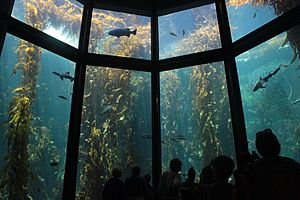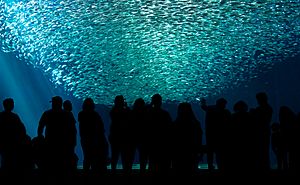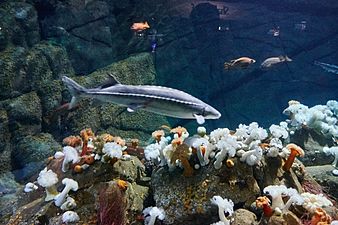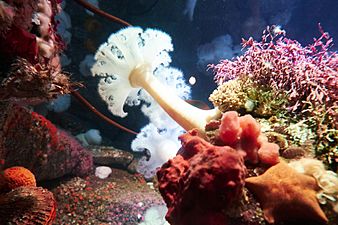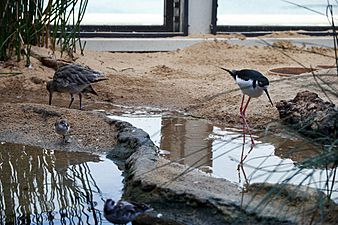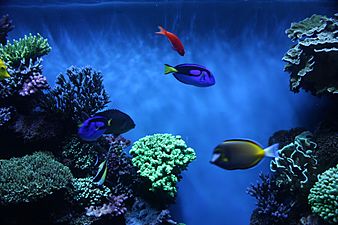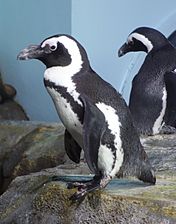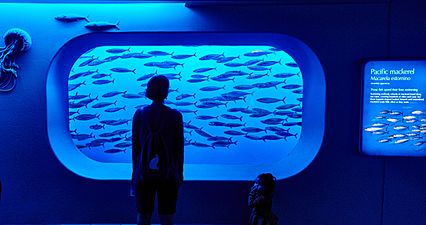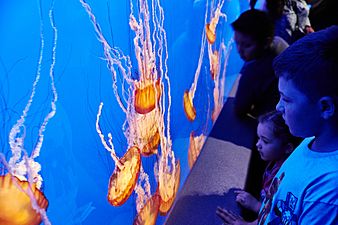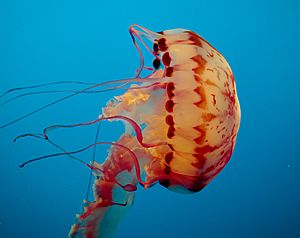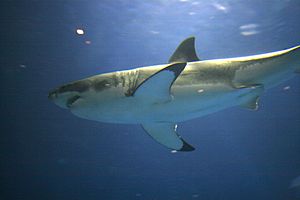Monterey Bay Aquarium facts for kids

The aquarium's logo depicts giant kelp
|
|
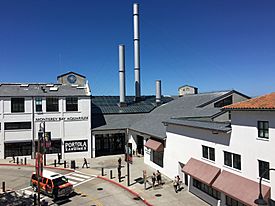
Main entrance in 2016, featuring the remodeled façade and fiberglass smokestacks of the Hovden Cannery
|
|
| Date opened | October 20, 1984 |
|---|---|
| Location | Cannery Row, Monterey, California, U.S. |
| Coordinates | 36°37′05″N 121°54′07″W / 36.6181°N 121.9019°W |
| No. of animals | ~81,000 -- Corresponds to number and source in section #Aquarium exhibits --> |
| No. of species | 771+ |
| Volume of largest tank | 1.2 million U.S. gallons (4.5 million liters) |
| Total volume of tanks | 2.3 million U.S. gallons (8.7 million liters) |
| Annual visitors | 2 million |
| Memberships | Association of Zoos and Aquariums |
| Major exhibits | Kelp Forest, Sea Otters, Jellies, Open Sea |
The Monterey Bay Aquarium is a special place in Monterey, California, that helps protect the ocean. It's famous for showing off the amazing sea life found right in Monterey Bay. When it opened in October 1984, it was the first aquarium to have a real, living kelp forest inside!
Scientists at the aquarium have also learned a lot about caring for jellyfish. They even managed to successfully keep and display a great white shark for a time. The aquarium also works hard to protect sea otters, different kinds of birds, and tunas. They created a guide called Seafood Watch in 1999. This guide helps people choose seafood that is caught or farmed in ways that are good for the ocean.
The aquarium was built where an old sardine factory used to be. It has won many awards for its cool design, its efforts to save the ocean, and its fun learning programs. About two million people visit the Monterey Bay Aquarium every year. It helped bring new life to the area called Cannery Row and brings a lot of money to Monterey County. The aquarium has also been featured in TV shows and movies.
Contents
Building the Aquarium
In the late 1970s, some marine biologists from Stanford University had an idea to build an aquarium in Monterey. They wanted to use the site of an old sardine factory called the Hovden Cannery. Before this, other ideas for an aquarium hadn't worked out.
Nancy Burnett, one of the biologists, shared the idea with her parents, Lucile and David Packard. David Packard was one of the founders of Hewlett-Packard. Their family foundation decided to help. They found out that an aquarium could attract many visitors. So, in April 1978, the Monterey Bay Aquarium Foundation was created. They bought the old factory site.
David Packard gave a lot of money to build the aquarium. He wanted it to be able to support itself financially after it opened. The aquarium's plans grew bigger after visits to other aquariums in Japan. In the end, the Packards paid $55 million for the project.
Designing a Special Place
The building company, Rudolph and Sletten, thought the aquarium would take about two and a half years to build. The architects, EHDD, wanted to rebuild the old factory instead of tearing it down. They felt it was important to keep the look of Cannery Row.
Some parts of the old factory were kept, like concrete sections. The old warehouse became offices. The factory's pump house, which used to bring fish from the bay, was turned into a system to bring seawater for the exhibits. The aquarium was built around the factory's old boiler house, which you can still see today as an exhibit.
Building over the water was tricky. Almost half of the aquarium sits over the bay. Workers had to install parts of the foundation during low tide, often at night. The ground under the beach sand was not always the same, which made digging difficult.
A Look Like the Past
The aquarium's design copied many features of the old Hovden Cannery. This included its windows, plain cement walls, and many roofs. Even the pipes and ducts on the ceiling were left exposed to match the industrial style of Cannery Row.
Many people felt the aquarium successfully looked like a cannery, even though it now showed live fish instead of processing them. The California Historical Society even gave it an award for preserving history.
When the Monterey Bay Aquarium opened on October 20, 1984, it was the biggest public aquarium in the United States. On opening day, 11,000 people visited. The aquarium announced, "the fish are back!" This was a fun way to say that fish were now being celebrated, unlike when overfishing caused the canneries to close.
In its first year, 2.4 million people visited. The aquarium quickly became one of California's most popular attractions. By 1994, it was the most visited aquarium in the U.S. The architects, EHDD, won several awards for their design. The Association of Zoos and Aquariums called the Monterey Bay Aquarium "a definite leader" in 2009. Julie Packard has been the aquarium's executive director since it opened.
Amazing Aquarium Exhibits
The founders of the Monterey Bay Aquarium wanted to share the marine life of the region with everyone. They did this through exhibits that showed the different ocean habitats of Monterey Bay and central California. This idea was inspired by a book about ocean life written in 1939.
In the early 1980s, this was a new way to design aquariums. Other big aquariums at the time focused on coral reefs or large sharks. They didn't show many local species.
How the Seawater System Works
The Monterey Bay Aquarium has about 35,000 animals from over 550 species. They live in 2.3 million U.S. gallons (8,700,000 L) of water. Cleaned seawater from Monterey Bay is pumped into the exhibits. For the Kelp Forest exhibit, unfiltered seawater is used at night to keep it looking natural.
Sometimes, the pipes need to be cleaned to remove organisms that grow inside them. The aquarium uses special tools called "pigs" that blast through the pipes under pressure. Most of the systems that keep the animals healthy are automatic. They track water conditions and help prevent mistakes.
The Kelp Forest Exhibit
The Kelp Forest exhibit is a main attraction in the Ocean's Edge wing. It's 28 feet (8.5 m) tall and 65 feet (20 m) long, almost three stories high! This exhibit was the first successful attempt to keep a living kelp forest in an aquarium.
When it was being planned, some people doubted that kelp could grow so big in an aquarium. Others thought visitors wouldn't be interested in seeing a local habitat. But the public loved it! The success of the giant kelp is thanks to direct sunlight, natural seawater from Monterey Bay, and a special machine. This "surge machine" creates pulsing water currents, just like in California's ocean. It helps the kelp grow about 4 inches (10 cm) every day.
Kelp forests are very important ocean ecosystems, like rainforests of the sea. Along with giant kelp, the exhibit has fish species found in Monterey Bay, such as rockfishes and leopard sharks.
The Open Sea Wing
In 1996, the aquarium opened a second wing called the Open Sea. It cost $57 million and took seven years to build. This wing almost doubled the aquarium's public space. It focuses on animals that live far out in Monterey Bay.
The Open Sea wing has three areas: one for different jellyfish and other tiny ocean creatures, a large exhibit for many kinds of ocean animals, and a section for "ocean travelers" like tufted puffins and sea turtles. When it opened, the aquarium had the most jellyfish on display in the world.
The Open Sea community exhibit is the aquarium's biggest tank, holding 1.2 million US gallons (4,500,000 L). It's 80 feet (24 m) long and 35 feet (11 m) deep. Its largest viewing window was reportedly the biggest aquarium window in the world when it was installed in 1996. To stop animals from swimming into the window at night, an air hose creates a "bubble wall."
In 2011, this exhibit had green sea turtles, sardines, pelagic stingrays, scalloped hammerhead sharks, and different kinds of tunas. The aquarium was the first in the U.S. to display an ocean sunfish in 1986. Between 2004 and 2011, six great white sharks were displayed here. This helped scientists learn a lot about them. Before this, no white shark had survived in an aquarium for longer than 16 days.
In 2011, the Open Sea wing had a 10-month, $19 million renovation. This was needed because large tunas were damaging the glass tiles, which sea turtles were then eating. The exhibit was drained, and all 10,000 animals were moved. New exhibits were added during this renovation, showing art about ocean problems like overfishing and marine plastic pollution.
Other Cool Exhibits
When it opened in 1984, the aquarium had 83 tanks in 12 galleries. By 2014, it had over 200 live animal exhibits. Besides the big Kelp Forest and Open Sea exhibits, there's the Monterey Bay Habitats tank. It's 90 feet (27 m) long and holds over 300,000 US gallons (1,100,000 L) of water. This exhibit shows different habitats in Monterey Bay, from wharfs to sandy seabeds and deep rocky reefs.
Many tanks in this exhibit use real structures from the bay or artificial rocks to make them look natural. Rescued sea otters live in a 55,000 US gallons (210,000 L) habitat. They are the only marine mammals displayed inside the aquarium. The aquarium doesn't keep whales or dolphins. Instead, visitors can watch the 27 species of marine mammals that live in or travel through Monterey Bay from decks at the back of the building.
The Monterey Bay Aquarium was the first public aquarium to have its inside mapped on Google Street View. This lets you take a virtual tour online!
-
A white sturgeon, rockfishes, and plumose anemones in the Monterey Bay Habitats exhibit
-
Pacific coral reef community containing living corals
-
African penguins on exhibit
-
Pacific sea nettles in a long kreisel tank
Special Exhibitions
The Monterey Bay Aquarium started creating temporary exhibits in the 1980s. These shows animals found outside Monterey Bay. The first one, in 1989, was about the Sea of Cortez. Most special exhibits since then have focused on groups of animals, like deep-sea animals (1999), sharks (2004), otters (2007), seahorses (2009), cephalopods (2014), and jellyfish.
An exhibit in 1997 called "Fishing for Solutions" led to the creation of the Seafood Watch program. In 2010, "Hot Pink Flamingos" was one of the first aquarium exhibits in the U.S. to talk about how global warming affects animals and their homes.
The aquarium has had at least three exhibits just for jellyfish. The success of "Planet of the Jellies" in 1992 led to a permanent jellyfish gallery in the Open Sea wing. The staff loves jellyfish because they look amazing, have simple bodies, and seem to make visitors feel calm.
In 2016, a new exhibit opened that showed land animals for the first time, including a tarantula, a snake, and a scorpion. In April 2022, a $15 million exhibit about deep-sea animals opened. It took over five years to develop. Scientists used special technology to collect animals from nearly 5,000 feet (1,500 m) deep. The aquarium had to build special tanks that were freezing cold, very acidic, and had low oxygen for these animals. Some animals displayed included glowing jellies, giant isopods, and sea angels.
Research and Ocean Protection
The Monterey Bay Aquarium helped create the Monterey Bay National Marine Sanctuary in 1992. This is one of the largest protected ocean areas in the United States. In 2004, the aquarium started a formal group to work on ocean laws and policies in the U.S.
Scientists at the aquarium have written many research papers about sea otters, great white sharks, and bluefin tunas. These are important species in the northern Pacific Ocean. They also publish work on animal care, visitor studies, and how to create museum exhibits. The aquarium is known as a leader in scientific research among aquariums and zoos.
The aquarium has won awards for its work in breeding animals in captivity. This includes their success with purple-striped jellies. They also won an award for their Sea Otter Research and Conservation Program. In October 2017, the World Association of Zoos and Aquariums gave the aquarium its Conservation Award for its dedication to protecting the ocean and raising public awareness.
Helping Marine Life
The aquarium's Sea Otter Research and Conservation program started in 1984. It helps study and rescue wild southern sea otters. As of October 2017, over 800 otters had completed the program. Researchers also collect data on wild sea otter groups using electronic tags.
The program also has "surrogate mothers." These are adult female sea otters that have been rescued but can't be released. They act as mothers to stranded sea otter pups. The aquarium was the only place in California that rescued sea otters until 2017. Their work with sea otters was even shown in a TV episode called "Saving Otter 501."
The aquarium also helps shorebirds, like the western snowy plover. Since 1998, they have worked with another group to rescue plover eggs. The eggs hatch after being kept warm artificially. The young birds are raised until they can live on their own, then released.
The aquarium's African penguins are part of a special breeding program to help protect this endangered species. Five chicks have hatched in the penguin colony as of 2014. Some of these have been sent to other aquariums. Since June 2007, the aquarium has a public show with a rescued Laysan albatross. This bird has a 6 feet (1.8 m) wingspan! The show teaches visitors about the dangers of marine plastic pollution for animals, especially albatrosses.
Pacific bluefin and yellowfin tunas have been shown in the Open Sea community exhibit. Some of these fish weighed over 300 pounds (140 kg). In 2011, there were three dozen tunas of these two species in the exhibit. The aquarium also has a Tuna Research and Conservation Center, which started in 1994 with Stanford University. Scientists there tag wild tunas to study how they hunt and how their bodies stay warm. In January 2016, the aquarium and Stanford hosted a meeting to discuss ways to manage bluefin tuna populations, which have been declining.
Aquarists also raise animals behind the scenes for the exhibits. Since 1985, the aquarium has been very involved in raising jellyfish. Their jellyfish collections have been the largest in the world. Their pioneering work with jellyfish led to many other aquariums in the U.S. creating jellyfish exhibits. In August 2016, aquarists successfully grew comb jellies in a lab for the first time. This might help them become a "model organism" for study.
Starting in 2012, the aquarium began breeding many kinds of cephalopods (like squid and octopuses) for a special exhibit that opened in 2014. Half of the animals in that exhibit were raised at the aquarium because they have short lives. The exhibit showed how aquarists raise different cephalopods, including bigfin reef squid, which only live for about six months. The aquarium also displayed at least two deep-sea cephalopod species, like flapjack octopuses and vampire squid.
Great White Sharks
In 1984, the Monterey Bay Aquarium tried to display a great white shark for the first time. It only lasted 11 days because the shark didn't eat and died. Later, through a program called Project White Shark, six white sharks were shown between 2004 and 2011 in the Open Sea exhibit.
Researchers found that the aquarium's success was due to using a large net pen. This gave the sharks time to recover after being caught. A special 3,200-US-gallon (12,000 L) tank was used to move the sharks. This tank allowed them to swim constantly, which they need to do to breathe. These efforts led to the first time a white shark ate in an aquarium.
Some groups criticized the aquarium for keeping white sharks in captivity. However, many scientists approved of Project White Shark. They liked its design, its educational impact, and the scientific information it provided. An Australian white shark researcher said in 2006 that "the fact people can come and see these animals and learn from them is of immeasurable value."
The first captive white shark, displayed in 2004 for over six months, was seen by one million visitors. Another million visitors saw the second or third white sharks. In 198 days, the first white shark grew over 17 inches (43 cm) and gained over 100 pounds (45 kg) before it was released. As of 2016, the Monterey Bay Aquarium is the only public aquarium in the world to have successfully displayed a white shark for longer than 16 days.
The effort to display captive white sharks ended in 2011 because it required so many resources. Also, captive white sharks sometimes got hurt or killed other animals in the exhibit when they became aggressive. The last shark died for unknown reasons right after it was released. Even though they no longer display white sharks, aquarium researchers continue to study them. In June 2016, they worked with another research group to attach cameras to harmless tags on white sharks. This helps them study the sharks' behavior.
Seafood Watch Program
The Monterey Bay Aquarium's Seafood Watch program helps people buy seafood that is caught or farmed in ways that don't harm the ocean or other wildlife. It started in 1999 and has grown a lot. It now includes a website, pocket guides, and mobile apps. These tools let people check how sustainable different types of seafood are.
The program also works with businesses, restaurants, and grocery stores. Big companies like Target and Whole Foods Market are involved. Seafood Watch has played an important role in discussions about sustainable fishing. The aquarium says the program works well because it helps both businesses and consumers. It's also supported by the aquarium's science and ocean policy programs.
In the late 2000s, Seafood Watch was probably the most well-known and widely used sustainable seafood guide in the world. By 2014, it had printed over 52 million pocket guides. Its mobile apps were downloaded over one million times between 2009 and 2015. The program has won several awards for its use of technology and its impact. In 2013, Sunset magazine called it one of "the most effective consumer-awareness programs."
In September 2016, the United States Agency for International Development announced it was working with the aquarium to improve fishing management in the Asia-Pacific region.
Speaking Up for the Ocean
The Monterey Bay Aquarium is active in politics, both at the state and national levels. They support laws about the ocean and encourage visitors and online followers to take action. The aquarium was a main supporter of the statewide ban on shark finning in 2011. After that, they focused on marine plastic pollution. They supported laws that limited the use of microbeads in personal care products.
The aquarium also supported a statewide ban on single-use plastic grocery bags in California in 2016. They created ads, web pages, and podcasts to encourage people to vote for it. The aquarium is a founding member of the Aquarium Conservation Partnership. This group of 20 public aquariums works together on ocean protection policies. In December 2016, they hosted a conference on plastic pollution at the Monterey Bay Aquarium. In July 2017, the aquarium and other members of the partnership started getting rid of their own plastic products, like plastic bags, straws, and bottles.
The aquarium is also a founding partner of The Ocean Project. This group surveys public opinion about aquariums and environmental issues. The aquarium also runs the Center for Ocean Solutions with Stanford University. This center focuses on ocean science, policy, and law. The aquarium has taken part in several international meetings about ocean policy, including the 2017 United Nations Ocean Conference. In March 2017, the Monterey Bay Aquarium publicly supported the March for Science. Their penguins even had their own miniature march!
Learning and Leadership
Every year, about 75,000 students, teachers, and chaperones from California can visit the Monterey Bay Aquarium for free. Another 1,500 low-income students, 350 teenagers, and 1,200 teachers take part in special educational programs throughout the year. Between 1984 and 2014, the aquarium hosted over 2 million students.
In 2009, the aquarium helped create "Climate Interpreter," an online resource. Other zoos, government groups, and schools use it to share materials about explaining climate change to the public.
The Bechtel Family Center for Ocean Education and Leadership is a 13,000-square-foot (1,200 m2) facility. It was proposed in 2018 and cost $42 million to build. This center has doubled the number of students and teachers the aquarium can help each year. The Monterey Bay Aquarium has won several awards for its educational programs and its efforts to promote diversity. In 2015, the Silicon Valley Business Journal gave the aquarium an award for helping to "shape a new generation of ocean conservation leaders."
Community and Local Economy

In 2015, the Monterey Bay Aquarium employed over 500 people and had 1,200 active volunteers. Between 1984 and 2014, 8,500 volunteers gave 3.2 million hours of their time. The aquarium attracts about 2 million visitors each year. By 2016, over 50 million people had visited. In 2015, it was the second most visited public aquarium in the United States, after the Georgia Aquarium. It also had 290,000 annual members in 2015.
The aquarium offers free admission programs for residents of Monterey County. These include "Shelf to Shore" with the county's library system, and "Free to Learn" with local nonprofit groups. The aquarium also offers free admission to Monterey County residents during a week in December. This event grew from almost 17,000 visitors in 1998 to 50,000 visitors in 2013. In 2014, the program was expanded to include nearby Santa Cruz and San Benito counties.
An annual event called "Día del Niño" offers presentations in Spanish, activities, and free admission for children under 13. Between 2002 and 2014, over 700,000 people visited for free through these outreach programs.
In 2013, the aquarium's operations and its 2 million visitors brought $263 million to the economy of Monterey County. In August 2016, an event at the aquarium raised over $110,000 to help with relief efforts for the Soberanes Fire.
In December 2020, the aquarium loaned a special deep-freeze fridge to Natividad Medical Center in Salinas. This allowed the hospital to store the Pfizer–BioNTech COVID-19 vaccine at very cold temperatures. The aquarium normally uses the freezer to keep biological samples. Because of the COVID-19 pandemic, the aquarium closed for a time. Between April 2020 and January 2021, 243 staff members were laid off or furloughed.
See also
 In Spanish: Acuario de la bahía de Monterey para niños
In Spanish: Acuario de la bahía de Monterey para niños


